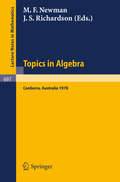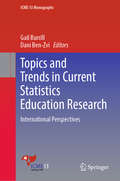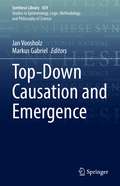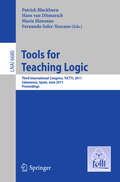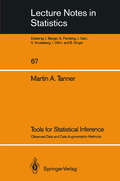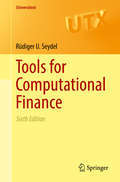- Table View
- List View
Topics in Algebraic and Topological K-Theory (Lecture Notes in Mathematics #2008)
by Paul Frank Baum Guillermo Cortiñas Ralf Meyer Rubén Sánchez-García Marco Schlichting Bertrand ToënThis volume is an introductory textbook to K-theory, both algebraic and topological, and to various current research topics within the field, including Kasparov's bivariant K-theory, the Baum-Connes conjecture, the comparison between algebraic and topological K-theory of topological algebras, the K-theory of schemes, and the theory of dg-categories.
Topics in Algebraic and Analytic Geometry. (MN-13), Volume 13: Notes From a Course of Phillip Griffiths
by Phillip A. Griffiths John Frank AdamsThis volume offers a systematic treatment of certain basic parts of algebraic geometry, presented from the analytic and algebraic points of view. The notes focus on comparison theorems between the algebraic, analytic, and continuous categories.Contents include: 1.1 sheaf theory, ringed spaces; 1.2 local structure of analytic and algebraic sets; 1.3 Pn 2.1 sheaves of modules; 2.2 vector bundles; 2.3 sheaf cohomology and computations on Pn; 3.1 maximum principle and Schwarz lemma on analytic spaces; 3.2 Siegel's theorem; 3.3 Chow's theorem; 4.1 GAGA; 5.1 line bundles, divisors, and maps to Pn; 5.2 Grassmanians and vector bundles; 5.3 Chern classes and curvature; 5.4 analytic cocycles; 6.1 K-theory and Bott periodicity; 6.2 K-theory as a generalized cohomology theory; 7.1 the Chern character and obstruction theory; 7.2 the Atiyah-Hirzebruch spectral sequence; 7.3 K-theory on algebraic varieties; 8.1 Stein manifold theory; 8.2 holomorphic vector bundles on polydisks; 9.1 concluding remarks; bibliography.Originally published in 1974.The Princeton Legacy Library uses the latest print-on-demand technology to again make available previously out-of-print books from the distinguished backlist of Princeton University Press. These editions preserve the original texts of these important books while presenting them in durable paperback and hardcover editions. The goal of the Princeton Legacy Library is to vastly increase access to the rich scholarly heritage found in the thousands of books published by Princeton University Press since its founding in 1905.
Topics in Algebra and Analysis: Preparing for the Mathematical Olympiad
by Radmila Bulajich Manfrino José Antonio Gómez Ortega Rogelio Valdez DelgadoThe techniques presented here are useful for solving mathematical contest problems in algebra and analysis. Most of the examples and exercises that appear in the book originate from mathematical Olympiad competitions around the world. In the first four chapters the authors cover material for competitions at high school level. The level advances with the chapters. The topics explored include polynomials, functional equations, sequences and an elementary treatment of complex numbers. The final chapters provide a comprehensive list of problems posed at national and international contests in recent years, and solutions to all exercises and problems presented in the book. It helps students in preparing for national and international mathematical contests form high school level to more advanced competitions and will also be useful for their first year of mathematical studies at the university. It will be of interest to teachers in college and university level, and trainers of the mathematical Olympiads.
Topics in Algebra: Proceedings, 18th Summer Research Institute of the Australian Mathematical Society, Australian National University, Canberra, January 9 - February 17, 1978 (Lecture Notes in Mathematics #697)
by M. F. Newman J. S. RichardsonTopics from the Theory of Numbers (Modern Birkhäuser Classics)
by Emil GrosswaldMany of the important and creative developments in modern mathematics resulted from attempts to solve questions that originate in number theory. The publication of Emil Grosswald’s classic text presents an illuminating introduction to number theory. Combining the historical developments with the analytical approach, Topics from the Theory of Numbers offers the reader a diverse range of subjects to investigate.
Topics from the 8th Annual UNCG Regional Mathematics and Statistics Conference (Springer Proceedings in Mathematics & Statistics #64)
by Jan Rychtář, Sat Gupta, Ratnasingham Shivaji and Maya ChhetriThe Annual University of North Carolina Greensboro Regional Mathematics and Statistics Conference (UNCG RMSC) has provided a venue for student researchers to share their work since 2005. The 8th Conference took place on November 3, 2012. The UNCG-RMSC conference established a tradition of attracting active researchers and their faculty mentors from NC and surrounding states. The conference is specifically tailored for students to present the results of their research and to allow participants to interact with and learn from each other. This type of engagement is truly unique. The broad scope of UNCG-RMSC includes topics in applied mathematics, number theory, biology, statistics, biostatistics and computer sciences.
Topics from Australian Conferences on Teaching Statistics: OZCOTS 2008-2012 (Springer Proceedings in Mathematics & Statistics #81)
by Helen MacGillivray Michael A. Martin Brian PhillipsThe first OZCOTS conference in 1998 was inspired by papers contributed by Australians to the 5th International Conference on Teaching Statistics. In 2008, as part of the program of one of the first National Senior Teaching Fellowships, the 6th OZCOTS was held in conjunction with the Australian Statistical Conference, with Fellowship keynotes and contributed papers, optional refereeing and proceedings. This venture was so successful that the 7th and 8th OZCOTS were similarly run, conjoined with Australian Statistical Conferences in 2010 and 2012. Authors of papers from these OZCOTS conferences were invited to develop chapters for refereeing and inclusion in this volume. There are sections on keynote topics, undergraduate curriculum and learning, professional development, postgraduate learning, and papers from OZCOTS 2012. Because OZCOTS aim to unite statisticians and statistics educators, the approaches this volume takes are immediately relevant to all who have a vested interest in good teaching practices. Globally, statistics as a discipline, statistical pedagogy and statistics in academia and industry are all critically important to the modern information society. This volume addresses these roles within the wider society as well as questions that are specific to the discipline itself. Other chapters share research on learning and teaching statistics in interdisciplinary work and student preparation for futures in academia, government and industry.
Topics and Trends in Current Statistics Education Research: International Perspectives (ICME-13 Monographs)
by Gail Burrill Dani Ben-ZviThis book focuses on international research in statistics education, providing a solid understanding of the challenges in learning statistics. It presents the teaching and learning of statistics in various contexts, including designed settings for young children, students in formal schooling, tertiary level students, and teacher professional development. The book describes research on what to teach and platforms for delivering content (curriculum), strategies on how to teach for deep understanding, and includes several chapters on developing conceptual understanding (pedagogy and technology), teacher knowledge and beliefs, and the challenges teachers and students face when they solve statistical problems (reasoning and thinking). This new research in the field offers critical insights for college instructors, classroom teachers, curriculum designers, researchers in mathematics and statistics education as well as policy makers and newcomers to the field of statistics education. Statistics has become one of the key areas of study in the modern world of information and big data. The dramatic increase in demand for learning statistics in all disciplines is accompanied by tremendous growth in research in statistics education. Increasingly, countries are teaching more quantitative reasoning and statistics at lower and lower grade levels within mathematics, science and across many content areas. Research has revealed the many challenges in helping learners develop statistical literacy, reasoning, and thinking, and new curricula and technology tools show promise in facilitating the achievement of these desired outcomes.
Topical Directions of Informatics: In Memory of V. M. Glushkov (Springer Optimization and Its Applications #78)
by Ivan V. SergienkoThis work is devoted to the late Ukrainian computer scientist V. M. Glushkov on the 90th anniversary of his birthday. Dr. Glushkov is known for his contribution to the world computer science and technology and this volume analyzes the ideas and paths of development of informatics formulated by him and demonstrate their important role in constructing computer technologies of basic research in the fields of applied mathematics, theories of computer programming and computing systems.A significant portion of the monograph is devoted to the elucidation of new results obtained in the field of mathematical modeling of complicated processes, creation of new methods for solving and investigating optimization problems in different statements and development of computer technologies for investigations in the field of economy, biology, medicine and information security in systems.The monograph will be of particular interest to informatics specialists and experts using methods of informatics and computer technologies to investigate complicated processes of different natures and developing new information technologies. It may also be useful for both graduate students and postgraduates specializing in Computer Science.
The Top Ten Algorithms in Data Mining
by Xindong Wu Vipin KumarIdentifying some of the most influential algorithms that are widely used in the data mining community, The Top Ten Algorithms in Data Mining provides a description of each algorithm, discusses its impact, and reviews current and future research. Thoroughly evaluated by independent reviewers, each chapter focuses on a particular algorithm and is wri
Top-Down Causation and Emergence (Synthese Library #439)
by Jan Voosholz Markus GabrielThis book presents the latest research, conducted by leading philosophers and scientists from various fields, on the topic of top-down causation. The chapters combine to form a unique, interdisciplinary perspective, drawing upon George Ellis's extensive research and novel perspectives on topics including downwards causation, weak and strong emergence, mental causation, biological relativity, effective field theory and levels in nature. The collection also serves as a Festschrift in honour of George Ellis' 80th birthday. The extensive and interdisciplinary scope of this book makes it vital reading for anyone interested in the work of George Ellis and current research on the topics of causation and emergence.
Tools of Total Quality: An introduction to statistical process control
by LyonnetFor a long time, quality has been one of industry's main preoccupations. It remains so today. There is some foundation for the statement that there is a 'quality crisis' in Europe, the methods traditionally used in our industries being unable to meet today's demands. Consequently it is essential to look for new directions in which to progress, taking account of the methods for achieving quality that have been developed in recent years. These methods impact on all parts of the industrial enterprise - marketing, manufacturing, research and development, after-sales services. All staff, administrative or technical, are involved. The present book describes the tools that can help anyone who is concerned with the concept of 'total quality'; it will also be a valuable educational aid for students reading for degrees or other qualifications in engineering. P. Lyonnet I General questions and concepts 1 INTRODUCTION: HOW CAN WE ACHIEVE TOTAL QUALITY? This book is concerned with the various techniques and methods of analysis that can be used to ensure total quality in a project. In this first chapter we show the costs that result from not achieving quality, so as to make clear how important a quality-assurance service is to any enterprise. We stress also the involvement of marketing, particularly in laying down specifications for reliability.
Tools for Teaching Logic: Third International Congress, TICTTL 2011, Salamanca, Spain, June 1-4, 2011, Proceedings (Lecture Notes in Computer Science #6680)
by Patrick Blackburn Hans Van Ditmarsch Maria Manzano Fernando Soler-ToscanoThis book constitutes the proceedings of the Third International Congress on Tools for Teaching Logic, TICTTL 2011, held in Salamanca, Spain, in June 2011. The 30 papers presented were carefully reviewed and selected from 62 submissions. The congress focusses on a variety of topics including: logic teaching software, teaching formal methods, logic in the humanities, dissemination of logic courseware and logic textbooks, methods for teaching logic at different levels of instruction, presentation of postgraduate programs in logic, e-learning, logic games, teaching argumentation theory and informal logic, and pedagogy of logic.
Tools for Statistical Inference: Methods for the Exploration of Posterior Distributions and Likelihood Functions (Springer Series in Statistics)
by Martin A. TannerA unified introduction to a variety of computational algorithms for likelihood and Bayesian inference. This third edition expands the discussion of many of the techniques presented, and includes additional examples as well as exercise sets at the end of each chapter.
Tools for Statistical Inference: Methods for the Exploration of Posterior Distributions and Likelihood Functions (Springer Series in Statistics)
by Martin A. TannerThis book provides a unified introduction to a variety of computational algorithms for likelihood and Bayesian inference. In this second edition, I have attempted to expand the treatment of many of the techniques dis cussed, as well as include important topics such as the Metropolis algorithm and methods for assessing the convergence of a Markov chain algorithm. Prerequisites for this book include an understanding of mathematical statistics at the level of Bickel and Doksum (1977), some understanding of the Bayesian approach as in Box and Tiao (1973), experience with condi tional inference at the level of Cox and Snell (1989) and exposure to statistical models as found in McCullagh and Neider (1989). I have chosen not to present the proofs of convergence or rates of convergence since these proofs may require substantial background in Markov chain theory which is beyond the scope ofthis book. However, references to these proofs are given. There has been an explosion of papers in the area of Markov chain Monte Carlo in the last five years. I have attempted to identify key references - though due to the volatility of the field some work may have been missed.
Tools for Statistical Inference: Observed Data and Data Augmentation Methods (Lecture Notes in Statistics #67)
by Martin A. TannerFrom the reviews: The purpose of the book under review is to give a survey of methods for the Bayesian or likelihood-based analysis of data. The author distinguishes between two types of methods: the observed data methods and the data augmentation ones. The observed data methods are applied directly to the likelihood or posterior density of the observed data. The data augmentation methods make use of the special "missing" data structure of the problem. They rely on an augmentation of the data which simplifies the likelihood or posterior density. #Zentralblatt für Mathematik#
Tools for Practical Software Verification: International Summer School, LASER 2011, Elba Island, Italy, Revised Tutorial Lectures (Lecture Notes in Computer Science #7682)
by Bertrand Meyer Martin NordioThe LASER school is intended for professionals from the industry (engineers and managers) as well as university researchers, including PhD students. Participants learn about the most important software technology advances from the pioneers in the field. The school's focus is applied, although theory is welcome to establish solid foundations. The format of the school favors extensive interaction between participants and speakers. LASER 2011 is devoted to software verification tools. There have been great advances in the field of software verification in recent years. Today verification tools are being increasingly used not only by researchers, but by programming practitioners. The summer school will focus on several of the most prominent and practical of such tools from different areas of software verification (such as formal proofs, testing and model checking). During the school the participants will not only learn the principles behind the tools, but also get hands-on experience, trying the tools on real programs.
Tools for Constructing Chronologies: Crossing Disciplinary Boundaries (Lecture Notes in Statistics #177)
by Caitlin E. Buck Andrew R. MillardThe first book to group together and analyze all the chronology construction methods used in different disciplines, this book will appeal to a wide range of researchers, scientists and graduate students using chronologies in their work; from applied statisticians to archaeologists, geologists and paleontologists, to those working in bioinformatics and chronometry. It is truly interdisciplinary and designed to enable cross fertilization of techniques.
Tools for Computational Finance (Universitext)
by Rüdiger U. SeydelComputational and numerical methods are used in a number of ways across the field of finance. It is the aim of this book to explain how such methods work in financial engineering. By concentrating on the field of option pricing, a core task of financial engineering and risk analysis, this book explores a wide range of computational tools in a coherent and focused manner and will be of use to anyone working in computational finance. Starting with an introductory chapter that presents the financial and stochastic background, the book goes on to detail computational methods using both stochastic and deterministic approaches.Now in its sixth edition, Tools for Computational Finance has been significantly revised and contains: Several new parts such as a section on extended applications of tree methods, including multidimensional trees, trinomial trees, and the handling of dividends;Additional material in the field of generating normal variates with acceptance-rejection methods, and on Monte Carlo methods;115 exercises, and more than 100 figures, many in color.Written from the perspective of an applied mathematician, all methods are introduced for immediate and straightforward application. A ‘learning by calculating’ approach is adopted throughout this book, enabling readers to explore several areas of the financial world.Interdisciplinary in nature, this book will appeal to advanced undergraduate and graduate students in mathematics, engineering, and other scientific disciplines as well as professionals in financial engineering.
Tools for Computational Finance (Universitext)
by Rüdiger U. SeydelThe disciplines of financial engineering and numerical computation differ greatly, however computational methods are used in a number of ways across the field of finance. It is the aim of this book to explain how such methods work in financial engineering; specifically the use of numerical methods as tools for computational finance. By concentrating on the field of option pricing, a core task of financial engineering and risk analysis, this book explores a wide range of computational tools in a coherent and focused manner and will be of use to the entire field of computational finance. Starting with an introductory chapter that presents the financial and stochastic background, the remainder of the book goes on to detail computational methods using both stochastic and deterministic approaches.Now in its fifth edition, Tools for Computational Finance has been significantly revised and contains:A new chapter on incomplete markets which links to new appendices on Viscosity solutions and the Dupire equation;Several new parts throughout the book such as that on the calculation of sensitivities (Sect. 3.7) and the introduction of penalty methods and their application to a two-factor model (Sect. 6.7)Additional material in the field of analytical methods including Kim’s integral representation and its computationGuidelines for comparing algorithms and judging their efficiencyAn extended chapter on finite elements that now includes a discussion of two-asset optionsAdditional exercises, figures and referencesWritten from the perspective of an applied mathematician, methods are introduced as tools within the book for immediate and straightforward application. A ‘learning by calculating’ approach is adopted throughout this book enabling readers to explore several areas of the financial world.Interdisciplinary in nature, this book will appeal to advanced undergraduate students in mathematics, engineering and other scientific disciplines as well as professionals in financial engineering.
Tools for Computational Finance (Universitext)
by Rüdiger U. SeydelTools for Computational Finance offers a clear explanation of computational issues arising in financial mathematics. The new third edition is thoroughly revised and significantly extended, including an extensive new section on analytic methods, focused mainly on interpolation approach and quadratic approximation. Other new material is devoted to risk-neutrality, early-exercise curves, multidimensional Black-Scholes models, the integral representation of options and the derivation of the Black-Scholes equation. New figures, more exercises, and expanded background material make this guide a real must-to-have for everyone working in the world of financial engineering.
Tools for Computational Finance (Universitext)
by Rüdiger U. SeydelTools for Computational Finance offers a clear explanation of computational issues arising in financial mathematics. The new third edition is thoroughly revised and significantly extended, including an extensive new section on analytic methods, focused mainly on interpolation approach and quadratic approximation. Other new material is devoted to risk-neutrality, early-exercise curves, multidimensional Black-Scholes models, the integral representation of options and the derivation of the Black-Scholes equation. New figures, more exercises, and expanded background material make this guide a real must-to-have for everyone working in the world of financial engineering.
Tools for Computational Finance (Universitext)
by Rüdiger U. SeydelTools for Computational Finance offers a clear explanation of computational issues arising in financial mathematics. The new third edition is thoroughly revised and significantly extended, including an extensive new section on analytic methods, focused mainly on interpolation approach and quadratic approximation. Other new material is devoted to risk-neutrality, early-exercise curves, multidimensional Black-Scholes models, the integral representation of options and the derivation of the Black-Scholes equation. New figures, more exercises, and expanded background material make this guide a real must-to-have for everyone working in the world of financial engineering.
Tools for Computational Finance (Universitext)
by Rüdiger U. SeydelTools for Computational Finance offers a clear explanation of computational issues arising in financial mathematics. The new third edition is thoroughly revised and significantly extended, including an extensive new section on analytic methods, focused mainly on interpolation approach and quadratic approximation. Other new material is devoted to risk-neutrality, early-exercise curves, multidimensional Black-Scholes models, the integral representation of options and the derivation of the Black-Scholes equation. New figures, more exercises, and expanded background material make this guide a real must-to-have for everyone working in the world of financial engineering.
Tools and Techniques for Social Science Simulation
by Ramzi Suleiman Klaus G. Troitzsch Nigel GilbertThe use of computer simulations to study social phenomena has grown rapidly during the last few years. Many social scientists from the fields of economics, sociology, psychology and other disciplines now use computer simulations to study a wide range of social phenomena. The availability of powerful personal computers, the development of multidisciplinary approaches and the use of artificial intelligence models have all contributed to this development. The benefits of using computer simulations in the social sciences are obvious. This holds true for the use of simulations as tools for theory building and for its implementation as a tool for sensitivity analysis and parameter optimization in application-oriented models. In both, simulation provides powerful tools for the study of complex social systems, especially for dynamic and multi-agent social systems in which mathematical tractability is often impossible. The graphical display of simulation output renders it user friendly to many social scientists that lack sufficient familiarity with the language of mathematics. The present volume aims to contribute in four directions: (1) To examine theoretical and methodological issues related to the application of simulations in the social sciences. By this we wish to promote the objective of designing a unified, user-friendly, simulation toolkit which could be applied to diverse social problems. While no claim is made that this objective has been met, the theoretical issues treated in Part 1 of this volume are a contribution towards this objective.



